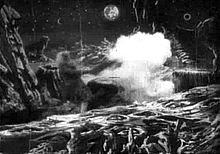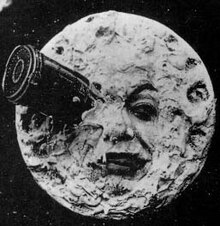The trip to the moon
| Movie | |
|---|---|
| German title | The trip to the moon |
| Original title | Le Voyage dans la Lune |
| Country of production | France |
| original language | French |
| Publishing year | 1902 |
| length | 16 minutes |
| Rod | |
| Director | Georges Méliès |
| script | Georges Méliès |
| production | Georges Méliès |
| camera | Michaut, Lucien Tainguy |
| occupation | |
| |
The trip to the moon (original title: Le Voyage dans la Lune ) is a science fiction film by the French film pioneer Georges Méliès from 1902.
action
At a congress of the Astronomical Society, Professor Barbenfouillis presented the plan to fly to the moon with a capsule shot down by a gigantic cannon . A scientist initially objects, but the decision to go on this trip is unanimous and the preparations begin immediately. The six selected astronauts examine the assembly of the capsule and watch from the roof of the institute how the cannon is poured .
The time has finally come for the astronauts to climb into the capsule with their umbrellas. The capsule is pushed into the cannon by some attractive ladies like a breech-loader . After the French tricolor has been raised , the fuse on the cannon is lit and the capsule is fired. You can see how it gets closer and closer to the moon and the capsule ultimately lands in the right eye of the moon's face . Then the capsule lands again in the lunar landscape. The scientists leave the capsule and admire the bizarre surface of the moon and the sight of the rising earth.
Tired of the journey, they go to sleep. Stars and planets come to life above them. Angry at the intruders, they send a shower of snow that wakes the spacemen who are fleeing the cold into a grotto. Giant mushrooms grow here, and when Barbelfouillis rams his umbrella into the ground, the umbrella turns into an ever-growing mushroom. Attracted by this, the Selenites, the inhabitants of the moon, attack the travelers. Although Barbenfouillis manages to hit two of the Selenites with another umbrella, whereupon they evaporate in a cloud of smoke, the Earthlings are overwhelmed by an overwhelming number of the inhabitants of the moon and led into the palace before the ruler of the Selenites and accused. But Barbenfouillis breaks his bonds, grabs and smashes the ruler on the ground. In the following scramble, the heroes manage to escape and return to the capsule. Barbenfouillis rocks the capsule on the edge of an apparently bottomless abyss, but only the leap of a selenite clinging astride the capsule plunges it down towards the earth.
The capsule falls into the ocean and first sinks to the sea floor, but then rises again to the surface due to its static buoyancy , where it is towed by a steamer to the nearest port. In the city, the adventurers are welcomed like heroes and enthusiastically celebrated. The mayor gives the returnee the knightly order of the moon trip, the captured selenite is presented on a leash and forced to dance. Finally, you dance rows of rings around a statue that was erected in honor of Barbenfouillis and science.
background

Based on the novels From the Earth to the Moon by Jules Verne and The First People on the Moon by HG Wells , Georges Méliès made The Journey to the Moon, one of the first science fiction films. The first performance took place on September 1, 1902 in the Paris Olympia . The Journey to the Moon , along with The Great Train Robbery (1903) and the first films by the Lumière brothers, is considered to be the best-known work from the early years of film history .
Unlike Auguste and Louis Lumière, Méliès was fascinated from the start by the possibilities of telling imaginative stories with the help of film. As a professional magician he was very familiar with the use of stage techniques and effects such as hidden trap doors or pyrotechnic effects , and many of these tricks can also be found in his films. In addition, he used new visual effects such as double exposures , split screens or stop-action or stop-motion , with which he could create scenes that could not be shown on the conventional theater stage . Above all, the sequence of the capsule flight with the landing in the man's right eye in the moon exemplifies Méliès' technical abilities. He not only acted as director , producer , screenwriter and leading actor in this film , but also designed the sets and costumes .
The elaborate set design made Die Reise zum Mond one of Méliès' most expensive productions, but it also became the most successful of his more than 500 films. However, he lost the income from the distribution of the film in the United States because technicians from Edison's film studio secretly made copies of the film and released them in the United States. Other film producers publish black copies of the film under other names, for example, Die Reise zum Mond was also listed as A Trip to Mars .
In 2002, a complete copy of the film was discovered in France, which is also completely hand-colored . There are many different versions of the film. On the other hand, the Méliès film is often wrongly assigned a sequence in which the open mouth of the moon's face is the target of space flight; These are actually scenes from the film Excursion dans la lune , shot in 1908 by the Spanish film pioneer Segundo de Chomón , whose style was based on Méliès' model. At that time, no subtitles were used to explain the plot, but Méliès had prepared a text that was often read to accompany the screenings (and can be heard on some American DVD releases). In addition, Méliès advertised the film in its catalog with a total of 30 chapter headings that give an overview of the plot.
The pictures from The Journey to the Moon have been quoted over and over again over the past hundred years. The gigantic cannon that fires the capsule appears in the science fiction film What will come , the man in the moon can be found in Baz Luhrmann's film Moulin Rouge . Original scenes from Trip to the Moon are in the music video " Heaven for Everyone " by Queen used (1995). The video " Tonight, Tonight " by Smashing Pumpkins (1995) is stylistically based on this. An episode of the television series From the Earth to the Moon produced by Tom Hanks is dedicated to the production of the film and contrasts Méliès' visions with the last manned moon landing of Apollo 17 . In the episode, his first trip to the moon (a reference to the movie title) of science fiction - animated series Futurama Bender throws a beer bottle in the left eye of Craterface (German: Crater Face). In the typical Futurama way, this can be understood as an homage. This scene is parodied in the last episode of Futurama. Bender throws a beer bottle into Craterface's left eye again, a little later Craterface is hit in the right eye by a beer bottle of the same brand.
Martin Scorsese's film Hugo Cabret takes up the story of Georges Méliès and shows some original film scenes.
Reviews
"A classic (not only) of science fiction cinema, which the 'auteur filmmaker' Georges Méliès realized with a fascinating mixture of stunning naivety and impressive inventiveness in trick technology."
Home video publishing
- Since the copyrights to the film expired, it has been released on DVD by various providers , including in 2008 and 2009.
- In 2012 Arthaus released the DVD "Georges Méliès - The Magic of Cinema" as well as the DVD and Blu-ray "Die Reise zum Mond" with a color version restored for € 400,000 and with music by the French pop group Air . In addition to the black-and-white version of the film, there is also a 65-minute documentary entitled Le voyage extraordinaire by Serge Bromberg and Eric Lange about Méliès ' career, the creation, rediscovery and the complex, almost impossible restoration of the film.
Film music
In 2012, Stephan König composed a film score that was premiered by the Leipzig Chamber Orchestra artentfaltung on June 1, 2012 in the MDR-Kubus .
See also
literature
- Author collective: Georges Méliès. Cinematic magician . KINtop (Volume 2). Stroemfeld / Roter Stern, Basel and Frankfurt am Main 1993, 207 pages, ISBN 3-87877-782-5
- Thomas Koebner : Film Genres: Science Fiction. Phillip Reclam Jun. GmbH & Co., Stuttgart 2003, ISBN 3-15-018401-0 , pp. 17-21.
Web links
- The trip to the moon in the Internet Movie Database (English)
- The Journey to the Moon in the online film database
- Die Reise zum Mond (Uni Music), 00:12:43, 1902 The restored film on YouTube
- Die Reise zum Mond The restored film in color from 2011 on YouTube
- The trip to the moon as a complete film in theInternet Archive
- Detailed description and analysis of the film (in English)
swell
- ↑ The Journey to the Moon. In: Lexicon of International Films . Film service , accessed August 23, 2017 .
- ↑ www.arthaus.de ( Memento of the original from December 4, 2013 in the Internet Archive ) Info: The archive link was inserted automatically and has not yet been checked. Please check the original and archive link according to the instructions and then remove this notice.
- ↑ In 1902, flights to the moon were something special in FAZ from May 9, 2012, page 28
- ↑ Die Reise zum Mond (1902) (Blu-ray) - jpc. Retrieved April 24, 2017 .

